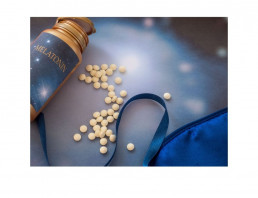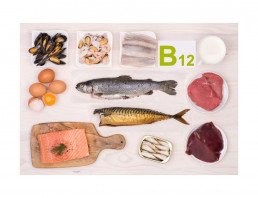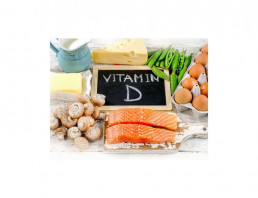Collagen
What is Collagen?
Collagen is a protein that binds tissue and is one of the main building blocks of the skin. It makes up around 75% of the dry weight in our skin. Collagen is made up of 3 amino acids: glycine, proline and hydroxyproline. Together these amino acids provide the skin with volume, giving it a plum look and feel and help wrinkles or lines stay away.
There are 28 types of collagen with three types that are most abundant in the body.
Type I: This is the main type of collagen and accounts for roughly 90% of the body’s collagen. It is made of densely packed fibers and is found in the skin, bones, tendons, fibrous cartilage, connective tissue and teeth.
Type II: This type is made of more loosely packed fibers and is found in the elastic cartilage, which cushions joints, and in the eyes.
Type III: This type supports the structure of muscles and blood vessels and is also found in the skin.
How is collagen made?
Collagen starts off as procollagen. Procollagen, a precursor, is a combination of two amino acids, glycine and proline. The process then involves steps to convert procollagen to collagen, which requires vitamin C. Therefore, if the body is deficient in vitamin C collagen cannot be produced with the risk of scurvy developing. Other amino acids involved hydroxyproline, glutamine, and arginine. In addition, minerals that support collagen production are manganese, copper and zinc.
What source of collagen should I use?
The sources of supplemental collagen depend on the type of collagen. If the source is beef or bovine, this supplies type I and III. If the source is chicken collagen this supplies type II. Fish collagen is type I and eggshell membrane is mostly type I and some type III and IV.
Type I and II collagen have specific benefits for the skin whereas is type III is best for cartilage. Small amounts of bovine collagen, type I and III, haven been used in the treatment of rheumatoid arthritis.
Look for hydrolyzed collagen. When a product is hydrolyzed collagen, that means the collagen is processed to smaller collagen molecules and the small intestine can efficiently absorb the collagen.
Collagen is animal source, how about if I am vegan?
Collagen must be from some type of animal or fish source. However, there are products that contain supplemental amino acids, vitamins and minerals that help the body make collagen molecules.
What about vitamin C?
One study found that vitamin C supplements can boost the production of type I and type III collagens. Vitamin C also induces the production of enzymes that encourage your body’s own natural collagen development. Without vitamin C your body cannot convert amino acids into the strands that form collagen fibrils.
What are additional ways to supplement or help delay the loss of collagen?
1. Use topicals to enhance collagen production to help replenish collagen stores. Retinoids or retinols: stimulate collagen synthesis in the skin. Alpha hydroxy acids, like glycolic acid, and peptides trigger collagen formation
2. In-office treatments performed by dermatologists: lasers, radiofrequency, ultrasound, micro-needling, fillers
Micro-needling: is a skin procedure that uses tiny needles that prick small holes in the top layer of skin. It is thought to disrupt the collagen and stimulates the body to form new, more youthful collagen fibers.
3. Protein-rich foods
4. Nutrients: vitamin C, zinc, copper
5. Wear broad-spectrum sunscreen with at least SPF 30
6. Regular skin massage: helps encourage the formation of procollagen-1 and enhance the benefits of anti-aging creams
Sleep, Melatonin & Breast Cancer
Insomnia
Sleep is required for survival in mammals. Adequate amounts are necessary for normal motor and cognitive function. It helps a person recover from illness, cope with stress and solve problems. Insomnia is the most common sleep problem. Primary insomnia is when a person is having sleep problems that are not directly associated with any other health condition or problem. Secondary insomnia is when a person is having sleep problems because of something else, such as a health condition including asthma, depression, cancer, pain or substance abuse.
What may cause insomnia?
Lifestyle, environment, psychological issues, menopause, illness or medical problems and some medications and supplements.
Melatonin
Melatonin, the hormone secreted by the pineal gland in our brain may also help reduce breast cancer. Studies are observational and experimental and mainly have been conducted on rodents.
What is the role of melatonin and breast cancer?
✨Melatonin helps decrease the incidence of breast cancer by enhancing the immune system. As we age, we lose the amount our body naturally produces melatonin, and hence our immune system declines.
✨Melatonin is also thought to block linoleic acid. Linoleic acid is a fat found in vegetable oils and is thought to promote tumor cells. Hence, melatonin helps reduce tumor size. Melatonin also helps fight cancer by fighting free radicals, and enhancing naturally occurring anti-oxidants such as glutathione, decreasing inflammation.
✨An interesting observation is the association of blind women with decrease incidence of breast cancer vs women that are night shift workers and flight attendants. This is thought to be caused by melatonin as blind women are not exposed to light and have higher levels of melatonin, vs workers that are working grave yard shifts.
What is the recommended dosage of melatonin and who should avoid melatonin?
✨Melatonin is available as a supplement, with the recommended dosage between 3 mg to 5 mg. It should be avoided by pregnant women, women wanting to become pregnant, breast-feeding, bleeding disorders, depression, diabetes, high blood pressure, seizure disorders or transplant recipients. Each person is different, so talk to your pharmacist and provider prior to supplementing.
References:
- González-González A, Mediavilla MD, Sánchez-Barceló EJ. Melatonin: A Molecule for Reducing Breast Cancer Risk. Molecules. 2018 Feb 6;23(2):336. doi: 10.3390/molecules23020336. PMID: 29415446; PMCID: PMC6017232. Accessed on 10/14/2020
Headaches
Types of Headaches
There are three primary types of headaches: migraines, tension, and cluster. Tension headaches are the most common type of headaches, while migraines are among the 10 most disabling lifetime conditions. Cluster headaches are the least common and unlike other headaches these headaches are more common in men.
In order to effectively reduce the occurrences of headaches it is important to have both a prevention and treatment plan. Prevention and treatment can include a variety of prescriptions, over the counter medications, lifestyle changes and herbals/supplements.
Prevention and treatment are important in reducing headaches. Treatment and prevention may consist of prescriptions, over the counter medications, lifestyle changes and herbals/supplements. Lifestyle changes may include eating regularly, adequate sleep, stress management, and using a headache diary.
There are a variety of different prescription medications that can be used for both treatment and prevention. In addition, over the counter medications including NSAIDs, such ibuprofen and naproxen, and acetaminophen may be useful. If a person is experiencing nausea and vomiting additional medications may be added such as Reglan and prochlorperazine. In office treatments such as Botox may be helpful for some.
Supplements and Herbals
Supplements and herbals are not FDA approved or regulated. The connection between using supplements and herbals is based more on anecdotal data.
Here I will list some herbs and supplements that may be used. Please be aware that these may not be suitable for everyone and you will want to discuss your options with your provider. Always look for reputable products, if they are USP certified that is a plus.
-
Willow bark contains salicin and is metabolized (broken down by the body) to salicylic acid. In fact, aspirin was originally derived from Willow bark. It is thought to work by inhibiting COX which decreases prostaglandins (inflammation).
-
Caffeine may work by blocking pain mediators or cause mood changes that modify pain. Yerba mate and Gurana both contain caffeine. Always be careful with excessive caffeine and caffeine withdrawal. Take caution with excessive caffeine as it may aggravate heart conditions, depression, anxiety, gastric ulcers.
-
Magnesium has also been researched in treating migraines. The citrate form has the most studies to support it use, however you may also look into magnesium glycine and magnesium L-threonate.
-
Peppermint oil has more support for tension headaches. It is applied topically to the temples and forehead and is thought to sooth and relax tension.
-
Vitex (chasteberry) is more for headaches related to PMS. It is thought to affect neurotransmitters and hormones, including dopamine, acetylcholine and opioid receptors. Some evidence suggests that it may also have effects on estrogen and progesterone and is more beneficial for low progesterone and high estrogen.
-
5-HTP is a precursor to serotonin which can affect pain sensation and thought to help prevent migraines. You will want to look for a USP certified brand. It may interact with tramadol, as there is a risk of serotonin syndrome.
-
A product called Sinol Headache Relief with the active ingredient, Capsicum, is an intranasal spray that works like topical capsaicin creams by depleting substance P which desensitizes nervous tissue. It is recommended to be used on the same side of the migraine. Pain and other side effects may occur, such as sneezing and teary eyes, that seem to subside after several applications.
-
For prevention butterbur 75 mg twice daily may help. Petadolex is brand that has been studied which contains extracts of petasin and isopetasin and showed a reduction in migraines by 48%. It is thought to have antispasmodic effects on the smooth muscle. The most frequent adverse effect is primarily burping. Also look for a high quality standardized extract that is PA free, otherwise it may lead to liver damage. Avoid in ragweed allergies.
-
Feverfew may inhibit platelet aggregation, serotonin release, leukotrienes, prostaglandin synthesis. Avoid if you are at increased risk of bleeding or taking warfarin. Also avoid in ragweed allergies. If you are to stop taking feverfew it is recommended to taper off dosage to prevent “post-feverfew syndrome” symptoms including nervousness, headache, insomnia, joint pain and tiredness.
-
Vitamin B2 also known as Riboflavin, may play a role in mitochondrial function. It has been suggested that migraine headaches could be partly due to mitochondrial dysfunction. Mitochondria are involved in oxidative energy metabolism. Riboflavin is required as a precursor for factors needed for electron transport in mitochondria.
-
Coenzyme Q 10
-
Melatonin: Keep in mind melatonin may not be safe in people who are pregnant or trying to get pregnant.
-
Fish oil might suppress inflammatory cytokines, prostaglandins, or leukotrienes and reduce headaches and most clinical evidence suggests it is not effective
Lifestyle Recommendations
There are also a variety of lifestyle recommendations that may help with reducing headaches.
Eating healthy and regularly is important in preventing migraines. Food and beverages that contain nitrites, monosodium glutamate (MSG), aspartame or neurotransmitter precursors (e.g. tyramine, tyrosine, phenylalanine) may trigger a migraine. Examples of foods that you may want to avoid are aged cheeses, cured meats (e.g. hot dogs, bacon), chocolate, alcoholic beverages (especially red wine), caffeine-containing beverages. Staying hydrated and moderate alcohol and caffeine intake is important as well. In addition, missed or delayed meals can also trigger migraine. Getting regular sleep is important as well as exercising regularly. Aerobic exercise may help as well as yoga. Working on reducing stress, massage and acupressure may help.
Headache Diaries
Headache diaries may help track headache triggers. Triggers may include personal and work-related stress, abnormal sleep (excessive, poor, restless), bright lights, certain smells, dietary factors, meteorological factors and neck pain. Hormones may also play a role.
References:
1. Dai YJ, Wang HY, Wang XJ, Kaye AD, Sun YH. Potential Beneficial Effects of Probiotics on Human Migraine Headache: A Literature Review. Pain Physician. 2017;20(2):E251–E255. Accessed on April 9 2020
2. Martami F, Togha M, Seifishahpar M, et al. The effects of a multispecies probiotic supplement on inflammatory markers and episodic and chronic migraine characteristics: A randomized double-blind controlled trial. Cephalalgia. 2019;39(7):841–853. doi:10.1177/0333102418820102. Accessed on April 9, 2020
Vitamin B12
Vitamin B12 and the Immune System
Published studies demonstrate that low vitamin B12 levels are linked to a decrease in the immune system. Vitamin B12 plays an important role in white blood cell production, acting as an immunomodulator. A study found that patients deficient in vitamin B12 had a decrease in the absolute number of CD8+ cells and suppressed NK cell activity (both are white blood cells). When patients were treated with B12 (the methylated form), augmentation of CD8+ cells was observed. The authors of the study concluded that vitamin B12 may acts as immunomodulator for cellular immunity, hence it is beneficial to our immune system.
What are B vitamins and what is vitamin B12?
Vitamin B is a water soluble vitamin. There are 8 types of vitamin B and each type has a different role. B vitamins may help with blood cell production, cognitive development, and increased energy.
Vitamin B12 helps keep the body’s nerve and blood cells healthy, and supports DNA production. It is a coenzyme involved in the metabolism of cells and plays a role in DNA synthesis and regulation, as well as fatty acid and amino acid metabolism.
Vitamin B12 may help prevent a type of anemia known as megaloblastic anemia. People with megaloblastic anemia may feel tired and weak. In pregnancy vitamin B12 promotes blood formation and may prevent birth defects. Vitamin B12 may lower homocysteine levels, which is thought to help prevent dementia and heart disease.
How does the body absorb vitamin B12?
There are two steps that are required for the body to absorb vitamin B12 from food. The first step involves hydrochloric acid, found in the stomach, which separates vitamin B12 from protein. The second step involves intrinsic factor, a protein made in the stomach, combining with vitamin B12. Once intrinsic factor combines with vitamin B12 the body can then absorb it. Some people have pernicious anemia, a condition in which they cannot make intrinsic factor. As a result, they have trouble absorbing vitamin B12 from all foods and dietary supplements. With this condition to bypass the gut, vitamin B12 injections are preferred.
What are symptoms or signs of low vitamin B12 levels?
Symptoms include premature graying hair, tingling and numbness in hands and feet, pernicious anemia, fatigue, constipation, weight loss. Deficiency tends to be rare, even in vegetarians, while children and babies are more at risk.
What are good dietary sources of vitamin B12?
Good sources include fish, dairy, meat, tempeh and miso.
What is the best form of vitamin B12?
The best form of Vitamin B12 is sublingual tablets (dissolved under the tongue), oral liquid, or B12 injections.
Vitamin B12 shots are preferred over tablets in the following situations:
1. You have low B12 levels (<200 ng/mL) and are experiencing symptoms (mental slowness, weakness and tingling in your extremities)
2. You have a GI disorder that might affect the absorption of Vitamin B12 (such as celiac disease, IBD, SIBO, bariatric surgery, etc.)
3. You are taking a medication that limits your absorption such as a proton pump inhibitors (PPI’s) or metformin therapy
4. You have the autoimmune disorder called pernicious anemia, which attacks vitamin B12 absorption by not making enough intrinsic factor. As mentioned before intrinsic factor is needed for vitamin B12 absorption
Which populations are at a greater risk for deficiencies?
People higher risk for deficiencies include the following:
1. Vegetarians and vegans (do not eat meat)
2. People aged 60 or over (more prone to chronic gastritis caused by H. Pylori)
3. People who regular use proton pump inhibitor’s (PPI’s) to help prevent stomach acid and people on diabetes drugs like metformin
4. People with Crohn’s disease, ulcerative colitis celiac or IBS
5. Women with a history of infertility and miscarriage
Are there any medications that may put someone at risk for vitamin B12 deficiencies?
There are certain medications that may increase the risk of vitamin B12 deficiency. These medications include stomach acid reducing medications, such as H2 blockers (examples include Zantac, Pepcid) and proton pump inhibitors (examples include Prilosec and Nexium). In addition, the following medications may reduce vitamin B12 absorption: colchicine commonly used for gout, metformin commonly used for diabetes, and AZT commonly used for AIDS. In addition, birth control may cause vitamin B12 deficiency (including also a deficiency in vitamin B2, magnesium, selenium and zinc).
What are the different types of vitamin B12? Which one is the best form to supplement with?
Vitamin B12 is cobalamin as it is the only vitamin that contains small amounts of cobalt. Cobalamin cannot be obtained from plants (as plants do not need vitamin B12) or sunlight and is produced in the gut of animals.
The different forms of cobalamin include: methylcobalamin, adenosylcobalamin, hydroxocobalamin and cyanocobalamin.
Methylcobalamin is the natural form that exists in the body and is readily absorbed. This is an active form of vitamin B12 and works with several enzymes to synthesize amino acids, produce red blood cells, repair DNA and assist with other important physiologic processes. There are claims that this form of vitamin B12 helps maintain normal circadian rhythms to assist with sleep and supports the body with methylation processes. It also assists with recycling homocysteine, which is linked to cardiovascular disease.
Adenosylcobalamin is another natural and active form of vitamin B12. It is required for cell energy and metabolism. The body is able to interconvert between adenosylcobalamin and methylcobalamin.
Hydroxycobalamin is a synthetic type of vitamin B12. This form is either engineered in the laboratory from bacteria or it is produced by bacteria in the digestive tract from food. It is a precursor to the active forms of vitamin B12. This means the body converts this form to the active forms: adenosylcobalamin and methylcobalamin. It is a precursor to the active forms of vitamin B12.
Cyanocobalamin is a man-made form that contains a cyanide molecule. Cyanide provides this form of vitamin B12 stability. Although cyanide is commonly associated with poison the amount is inconsequential to cause harm. The FDA has approved its use and it has been demonstrated not to cause toxicity. The body easily converts cyanocobalamin to the active forms. The body does this by the liver detoxing the cyanide molecule and modifying the vitamin to methylcobalamin by attaching a methyl group.
References:
1. Tamura J, Kubota K, Murakami H, Sawamura M, Matsushima T, Tamura T, et al. Immunomodulation by vitamin B12: augmentation of CD8+ T lymphocytes and natural killer (NK) cell activity in vitamin B12-deficient patients by methyl-B12 treatment. Clin Exp Immunol. 1999;116(1):28–32.
2. Mikkelsen K., Apostolopoulos V. (2019) Vitamin B12, Folic Acid, and the Immune System. In: Mahmoudi M., Rezaei N. (eds) Nutrition and Immunity. Springer, Cham
Elderberry (Sambucus Nigra)
Sambucus nigra, Elderberry
Elderberry, also known as Sambucus nigra, is great for colds and may help invoke sweating and diuresis. It helps induce sweat and relieves joint and muscle pain during fevers. There are small studies to support antiviral properties, immune modulation and antioxidant properties.
Studies involving patients with influenza have shown a reduction in symptoms when taking Elderberry. The studies reported Elderberry shortens the duration of flu symptoms such as fever, fatigue, headache, sore throat, cough and body aches. These studies concluded that further larger studies are needed to confirm the results.
In addition, in vitro studies (not humans) have proven Elderberry to be effective against numerous strains of influenza. It is thought that the constituents help neutralize the activity of the hemagglutin. Hemagglutin is found on the surface of the virus and by neutralizing the activity of hemagglutin the virus becomes inactive and is unable to infect cells.
Elderberry can be used during active flu (optimally combined with Oregano Oil or Echinacea Goldenseal), or used as a preventative to avoid getting sick during the flu season.
Elderberry has a high concentration of anthocyanins. These are purple pigments (also what gives Elderberry its color) serve as antioxidants and enhance immune function (by immune modulation) stimulating the innate immune system and boosting the production of cytokines. Cytokines are proteins that regulate the immune response. Elderberry is also rich in flavonoids, quercetin (thought to be a natural antihistamine) and vitamin A and C. It can be taken daily to help strengthen a person’s immune system. Stronger immune systems have a better chance of fighting infections.
Elderberry may also offer cardiovascular protection. This is thought to be due to its oxidative properties and reducing the oxidation of LDL cholesterol. LDL is bad cholesterol and is a risk factor for cardiovascular disease. By helping to reduce LDL it may benefit people with high cholesterol. In addition, it has the ability to potentially improve endothelial cells to help with vascular function. Studies have been very small and larger studies are needed to warrant the effect on LDL and the cardiovascular system.
At Rancho Pharmacy we carry Elderberry, both for adults and kids! Stop by today to get your bottle of Elderberry!
References:
1. V. Barak, T. Halperin, I. Kalickman. The effect of Sambucol, a black elderberry-based natural product, on the production of human cytokines: I. Inflammatory cytokines. European Cytokine Network. 2001;12(2):290-6 https://www.ncbi.nlm.nih.gov/pubmed/11399518Accessed on March 23, 2020
2. http://www.altmedrev.com/archive/publications/10/1/51.pdf. Accessed on March 23, 2020
3. Zakay-Rones Z, Varsano N, Zlotnik M, et al. Inhibition of several strains of influenza virus in vitro and reduction of symptoms by an elderberry extract (Sambucus nigra L.) during an outbreak of influenza B Panama. J Altern Complement Med. 1995;1(4):361–369. doi:10 Access on March 23, 2020
Vitamin D
Vitamin D AND the Immune System
COVID-19 is increasingly on people’s minds and many are focusing on how to keep their immune systems strong. There is a link between vitamin D and strong immune systems. Vitamin D can regulate the innate and adaptive immune responses. When vitamin D is deficient there is a link to autoimmune disease and an increased susceptibility to infection. Cod liver oil, which has a high content of vitamin D, is often used in tuberculosis treatment. A report that included almost 19,000 patients from the years of 1988 to 1994, showed patients reporting low levels of vitamin D (<30 ng/ml) also self-reported recent upper respiratory infections. Although recent studies have not shown consistent results, most likely due to methodological concerns, there is one well-designed study in school aged children that demonstrated that vitamin D administration decreased the flu (influenza) by 42%.
What is vitamin D and what role does it play?
Vitamin D is a fat soluble vitamin that helps support healthy bones through calcium absorption, promoting bone mineralization, and providing immune and cardiovascular support. It also plays a role in muscle function and the brain function and emotional health.
Which vitamin D supplement is best? How much vitamin D?
There are two major types of vitamin D, vitamin D3 and vitamin D2. Humans produce vitamin D3, also known as cholecalciferol, in their skin when exposed to sunlight. The only other source of vitamin D3 is found in animals. Vitamin D2 is sourced from plant foods and is known as ergocalciferol.
Calcidol, also known as 25-hydroxyvitamin D3, is a pre-hormone made directly from cholecalciferol (vitamin D3). This occurs in the liver by the enzyme 25-hydroxylase CYP27A1. This pre-hormone is not active; however, it is the major form of vitamin D that circulates in the bloodstream. Vitamin D blood tests typically measure the concentration of this pre-hormone. The activated form is known as calcitriol (1,25-dihydroxyvitamin D3). The enzyme 1-alpha-hydroxlation CYP27B1, converts the pre-hormone (calcidiol) in the kidneys to the active form, calcitriol. This is the most potent steroid hormone in the body. (Yes Vitamin D is a hormone, and technically calling it a vitamin is a misnomer).
Most studies show that vitamin D3 (cholecalciferol) is more effective than vitamin D2 (ergocalciferol) at raising blood levels of calcifedol. The recommended daily dose is 2,000 IU of vitamin D3 per day. Always check with your provider before supplementing.
What about when we age, what happens to our vitamin D?
Studies have found as people age; they lose the amount of vitamin D they are able to produce from the sun. This may be a result of the loss of enzymes needed to synthesize the vitamin. Research has found that low levels of vitamin D may be linked to poor cognitive performances in seniors. In addition, if a person receives an adequate amount of vitamin D it may significantly lower levels of inflammation and physiologic stress, factors that may slow down aging.
What do my lab levels mean and what is normal?
Typically blood tests measure the levels of the inactive pre-hormone, Calcidol (25-hydroxyvitamin D3). Although this hormone is not active it is the most reliable measurement of an individual’s vitamin D level. Lab level numbers will vary from lab to lab and providers may differ in what they believe is normal or low. However, most experts recommend having a level between 20 ng/ml to 40 ng/ml, and many will also push for levels between 30 ng/ml to 40 ng/ml. In general levels below 10 ng/ml are considered deficient. If you have your lab levels drawn for vitamin D you will want to work closely with your provider to determine if your levels are low.
References:
- https://www.ncbi.nlm.nih.gov/pmc/articles/PMC3166406/. Accessed on March 20, 2020
- Urashima M, et al. Randomized trial of vitamin D supplementation to prevent seasonal influenza A in schoolchildren. Am J Clin Nutr. 2010; 91(5):1255–60. [PubMed: 20219962] Accessed on March 20, 2020
Is it COVID or Is it My Allergies?
Is it COVID or is it my allergies?
Spring is the season of pollen and that means allergies. But what if you are experiencing symptoms how do you know it is not COVID and it's just your alleriges?
Symptoms of COVID vs Allergies
Well per the CDC symptoms of COVID include a cough, fever, and sore throat. With allergies you will not experience a fever. This is a big clue that if you have a fever, it's probably something other than your allergies.
WIth allergies you may experience itchiness in your throat, but it should not feel sore. Also, with allergies you may experience itchy eyes, nose and ears.
With COVID you might feel extreme exhaustion, this not common with allergies. In addition, if it is your allergies you might have a runny nose and congestion and possibly a cough. However if you are feeling short of breath, where you are having trouble breathing this is probably not due to your allergies and is something else that needs medical attention.
If you are having trouble breathing or experiencing bluish lips or face, confusion or persistent pain or pressure in the chest you should seek medical attention immediately.
This post is not designed to substitute medical advice from your provider. If you have concerns, please always contact your healthcare provider.
References
- https://www.cdc.gov/coronavirus/2019-ncov/symptoms-testing/symptoms.html accessed on 11/27/2020






